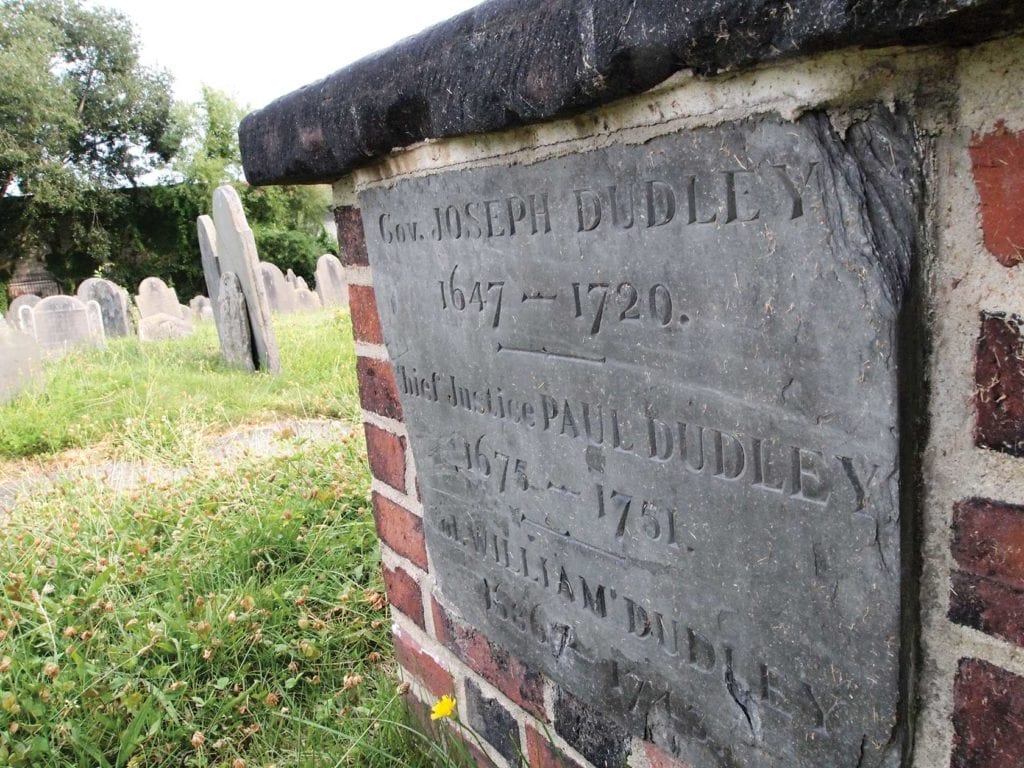Preserving Roxbury’s colonial history in stone
Nonprofit conducts inventory of markers in burying ground

When the Puritans arrived in Roxbury 390 years ago, a common burial ground was essential, as death was a constant companion to the English settlers. Over the next two centuries, the Eliot Burying Ground piled up with those who died early deaths in the cold winters of the New World, those fortunate enough to die of old age, and the dead from King Philip’s War of 1675, the French and Indian War of 1754, the Revolutionary War and the War of 1812.
By the time the burial ground closed for new interments in 1854, Roxbury was a changed place. As the Puritans’ Calvinist ideals gave way to Unitarianism, winged skulls representing departing souls were eschewed in favor of the classical Greek and Roman urns and willow boughs.

Many stones, such as these un-dated 18th century slate markers, are remarkably well preserved. BANNER PHOTO
For much of the last 200 years, the graveyard in Dudley Square has remained relatively undisturbed behind a wrought-iron gate, notes Byron Rushing, a founding member and former director of the Roxbury Historical Society.
“It’s always been in pretty good shape because it was almost always locked,” Rushing said. “Unlike the downtown [burial grounds], you don’t have people coming in every day.”
Nevertheless, repeated cycles of freezing and thawing have had an effect on many of the Eliot Burying Ground’s headstones, causing some to crumble.
In an effort to take stock of the headstones — the oldest above-ground, man-made structures in Roxbury — staff at Historic Boston Incorporated are now conducting an inventory, recording the state of each marker to aid in the restoration of damaged stones.
“The goal is to restore the stones as much as possible,” said HBI office manager Gabrielle Chapman, who is conducting the inventory.
From HBI’s office in the restored Eustis Street Fire House, Chapman is able to look out over the jumbled rows of headstones. On the ground, conducting the inventory, Chapman says she has gained a greater appreciation for the history of the burial ground.
“The dates are astounding sometimes,” she said. “To think that someone carved a stone and buried it almost 400 years ago, that really blows my mind.”
Of the seven 17th-century burying grounds in Boston, the Eliot is unique in that the headstones have not been dug up and rearranged, as is the case in the downtown-area graveyards. The jumble of graves remains in the same chaotic configuration in which they were laid out in centuries past. Another feature of this cemetery that has been lost in other Boston burial grounds is the presence of footstones — smaller grave markers that were placed at the foot of a grave. The existence of the footstones, however, makes the inventory a bit more challenging, Chapman said.
“It makes it a little confusing,” she said. “You don’t know if you’re looking at a headstone or a footstone sometimes.”
The information Chapman gleans from the burial ground will be given to the city’s Parks Department, which will use it to update its inventory of the 12,000 markers in Boston’s historic cemeteries.
Kelly Thomas, director of historic burying grounds for the Parks Department, will use the information for the city’s ongoing restoration efforts.
“I have a fragment collection of missing pieces that have been removed from the sites,” Thomas said. “They’re all organized. Anything that can be put back together will be returned to the site.”
Depending on the nature of the fracture and the type of stone, missing pieces of the markers can be attached using special stone epoxies, cement, mortar or, in some cases, stainless steel pins.
“Ultimately, the goal is that people don’t notice your work,” Thomas said. “You don’t want to look flashy.”
During its more than 200 years of activity, the Eliot Burying Ground received the bodies of many of Roxbury’s most prominent residents. It’s thought that there are three times as many bodies interred in the cemetery as there are grave markers, as many families could not afford stones, Rushing said.
Among the more notable interments was the Rev. John Eliot, who arrived in Roxbury in the 1630s, was among the founders of Harvard College and worked with Native Americans to translate the King James Bible into the Algonquian language in 1663 — the first Bible published in British North America. Also interred in the cemetery are members of the Dudley family, for whom Dudley Street was named and, until recently, the square at the intersection of Dudley and Washington Streets.
Another noted resident is Benjamin Tompson, said to be the first native-born English poet in the American colonies, who penned a 20-page poem about King Philip’s War, titled “New England’s Crisis.”
The gate to the Eliot Burying Ground remains locked, but people interested in visiting can have the gate unlocked by staff at HBI during its business hours or by the city’s Parks Department, usually with a day’s advance notice.
Chapman says the cemetery occasionally sees visitors from elsewhere in the country who are descendants of early Roxbury colonists.
“People are looking for relatives,” she said. “It’s a lot of Southerners, which I wouldn’t expect. We’ve had people from as far away as Kentucky.”






